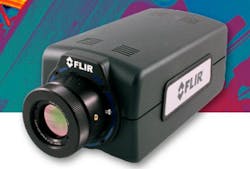Compact, thermal imaging camera for industrial research introduced by FLIR Systems
WILSONVILLE, Ore., 30 June 2014. FLIR Systems in Wilsonville, Ore., is introducing the A6700sc compact, thermal imaging camera for industrial research and development to enable users to capture and record thermal distribution and thermal variations in real-time.
The electro-optical sensor enables engineers and researchers to see and measure heat patterns, dissipation, leakage, and other temperature factors in equipment, products, and processes.
The FLIR A6700sc is for applications that need better image quality, more sensitivity and a higher frame rate than what can be obtained from a thermal imaging camera with an uncooled detector, FLIR officials say.
The camera works with FLIR ResearchIR Max software, enabling intuitive viewing, recording, and advanced processing of the infrared data provided by the camera. Each camera comes with this software.
Related: FLIR Systems to design thermal imaging sensors for Navy and Coast Guard patrol boats
Designed for electronics inspections, medical thermography, manufacturing monitoring, and non-destructive testing, the camera is for high-speed thermal events and fast-moving targets.
Short exposure times enable users to freeze motion and achieve accurate temperature measurements. In fact, the camera’s image output can be windowed to increase frame rates to 480 frames per second to characterize even higher speed thermal events, helping ensure critical data doesn’t get missed during testing.
A6700sc cameras stream temperature-calibrated data over Gigabit Ethernet to a PC for live image viewing and recording. Using FLIR’s ResearchIR software, researchers and scientists can monitor, acquire, analyze, and share data.
Related: Navy chooses multi-sensor electro-optical targeting pods from FLIR for copters and UAVs
In addition, extender rings for zoomed-in fields of view help the camera image small thermal targets, and close-up lenses can detect spot sizes down to 15 microns per pixel.
For more information contact FLIR Systems online at www.flir.com.

